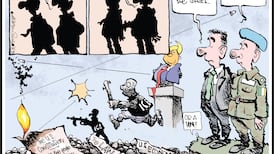When the British military authorities despatched the HMS Helga up the river Liffey on April 25th, 1916, to shell Boland's Mill and other insurgent positions in the capital, two Irish crewmen on board refused to assist.
It was a small but significant act, following a particular pattern, according to the late maritime historian Dr John de Courcy Ireland. As he noted in research published for the Rising’s 50th anniversary in 1966, mutinies in the Russian navy in 1917, and by Yugoslav and Czech seamen in the imperial Austro-Hungarian and German navies the following year, were “decisive factors in destroying those empires”.
The two men on the Helga probably knew their protest wasn't in that league, and the fact that their names have been forgotten reflects one of 1916's harsh realities. Their action was wasted on the Rising's leaders, who had no consciousness of the sea's importance, Dr Ireland noted – with the exception of Erskine Childers, Roger Casement and Darrell Figgis.
His own understanding of the sea and his facility for languages in consulting primary sources, including ship’s logs, is reflected in his 52-page pamphlet – which has all the ingredients of a thriller, and reads at times like one too. There is the German navy lieutenant who was assigned to deliver arms on a liner posing as a Norwegian steamer, and who survived hurricanes, dodgy navigation, and close encounters with spotter vessels before being forced into drastic action off the Cork coast.
There is the submarine, carrying a very seasick Roger Casement, which was meant to rendezvous with the “Norwegian” off Kerry. And there is Dr Ireland’s recording of some “unexplained phenomena” observed by the British Meteorological Office during the period of late April 1916, including clear sightings of the Aurora Borealis in various parts of southern Ireland.
Roger Casement believed German naval assistance to be "indispensable" to independence, but the Rising's leaders didn't appreciate what that entailed, Dr Ireland wrote – and Casement himself became increasingly disillusioned with Germany's lack of real interest. However, on April 9th, 1916, Lieut Karl Spindler set sail with a cargo of guns on the Libau – renamed the Aud, to masquerade as a Norwegian-registered steamer of this name.
Spindler’s cat-and-mouse experiences with British vessels – it emerged afterwards that the British Admiralty knew the details of the entire plan – and his battle with a hurricane on April 17th/18th are documented by the maritime historian.
The sea was “phenomenal, precipitous, waves towering, thirty-six feet and above”, Spindler wrote in his log, after he almost lost his ship to the Rockall Bank. Lacking food and sleep, he made several navigational errors off the Kerry coast.
Dr Ireland also recorded the voyage of Casement back to Ireland, along with Robert Monteith and Daniel Beverly, on board the German U-19 submarine. Its commander, Raimund Weisbach, who, he wrote, displayed “high professional competence”, seemed to be unaware of Casement’s intention to avert military action.
Spindler's expected time of arrival (ETA) in Tralee Bay was April 20th. Unfortunately, the German naval authorities had refused to equip the Libau with a radio, and so he never received the subsequent request from the Irish leaders to hold off until Sunday, April 23rd.
Captured by the British navy and escorted to Cork, Spindler scuttled his ship on April 22nd off the Cork coast before being taken prisoner.
However, even if he had had communication, Spindler would have been put in an impossible position, Dr Ireland believed.
As the historian pointed out, “a little knowledge of the hazards of sea-voyaging, particularly in war time and in the far northern waters of the Atlantic, would have convinced our leaders that it is not feasible to restrict the arrival of a ship at a certain point ...”
Couple that with the lives lost in a promised German engagement with British naval forces in the North Sea at the height of Rising, and the fact that British maintained control of Irish waters, and the insurrection was never going to succeed, he believed.
Had it not been for the cargo of arms landed by Erskine Childers on the Asgard in Howth harbour in 1914, it "could hardly have taken place at all", he wrote.
Only wily Weisbach on his U-19 managed to slip the all-embracing British net. Dr Ireland observed that the lesson of 1916 – “learned somewhat slowly” – influenced the then government’s decision in 1939 to establish Irish Shipping Ltd. The merchant line ensured delivery of vital supplies – at the cost of Irish seamen’s lives – during the second World War.
A ceremony remembering Casement’s capture at Banna Strand is on the Government’s centenary programme for next year. A tribute to Dr Ireland’s research of the background to that event, and his pioneering work to highlight the importance of the “blue field” long before it was deemed economically profitable , would surely not break the bank.
The Sea and the Easter Rising 1916 by Dr John de Courcy Ireland was published by the Maritime Institute of Ireland in 1966, and is now out of print.










